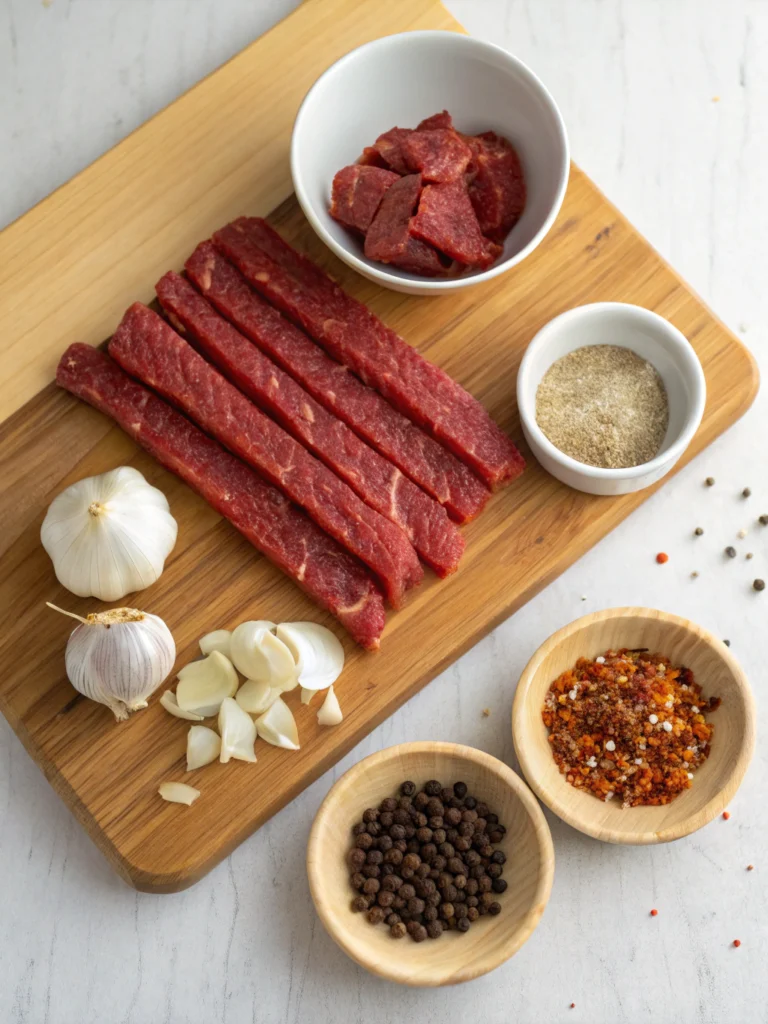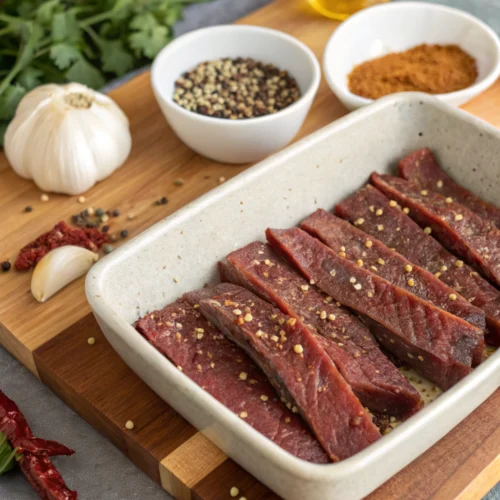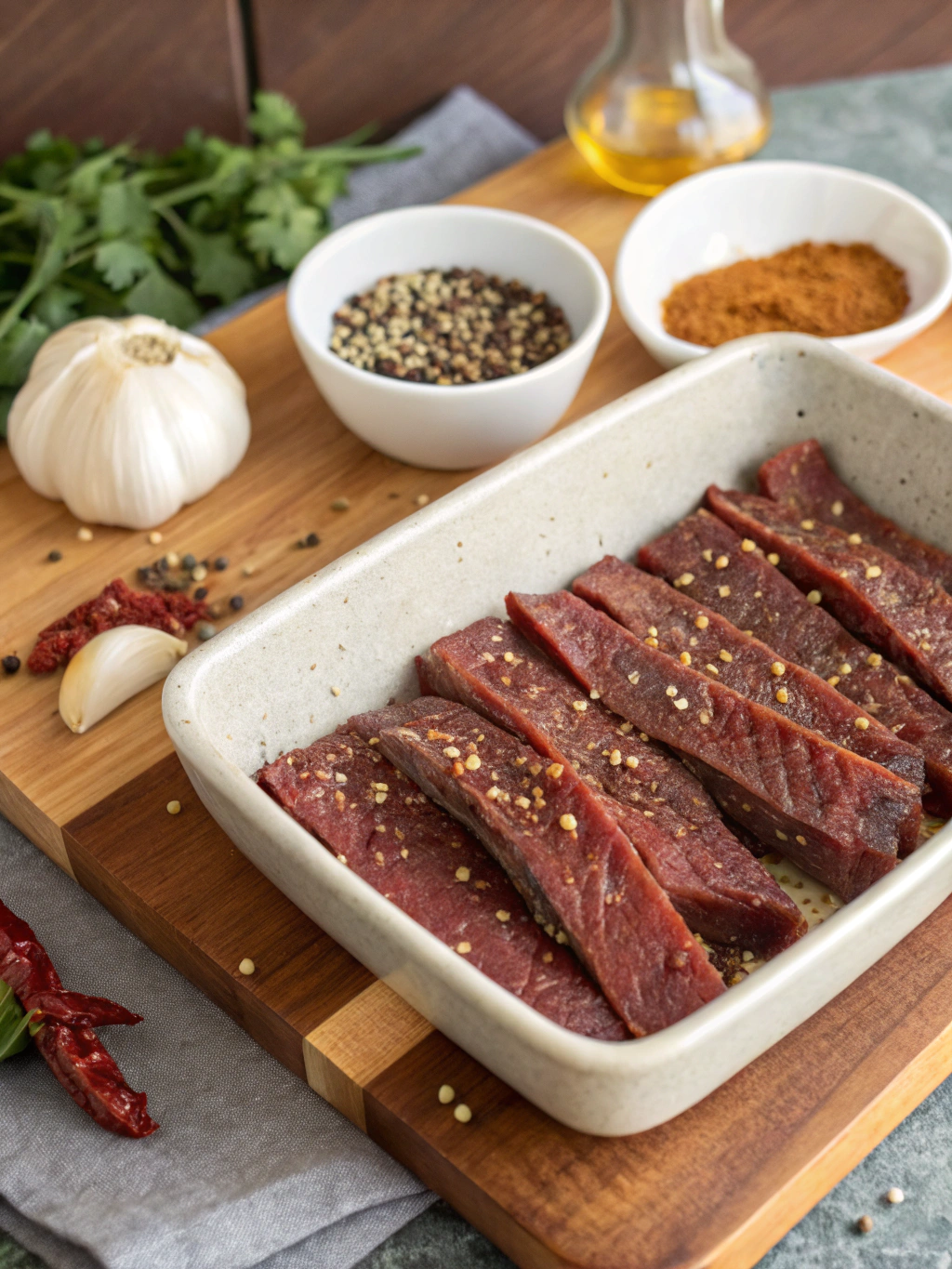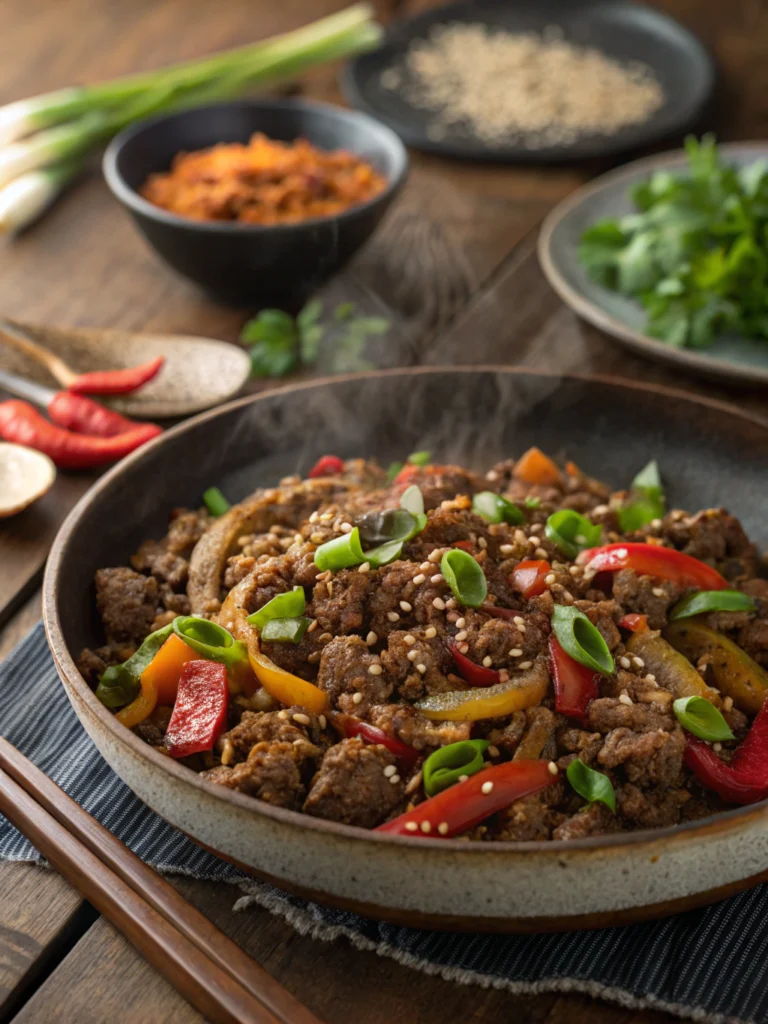Beef Stick Recipe: 7 Savory Steps to Homemade Snack Perfection
Introduction
Did you know that Americans consume over 2.5 billion pounds of beef snacks annually, yet 73% have never attempted making their own beef sticks at home? This striking disconnect exists despite homemade beef sticks containing up to 60% less sodium and preservatives than their commercial counterparts. Creating your own beef stick recipe allows complete control over ingredients, flavor profiles, and nutritional content, transforming a convenient snack into a healthier, more satisfying culinary achievement. From selecting the perfect meat blend to mastering the ideal smoking temperature, this comprehensive guide will walk you through creating beef sticks that rival (and often surpass) store-bought varieties in both taste and quality.
Ingredients List


Beef Stick Recipe
Equipment
- Sausage stuffer With 21-23mm stuffing tube
- Mixing bowl Large enough for 6 lbs of meat
- Stand mixer Optional, with paddle attachment for efficiency
- Smoker or oven Oven-safe rack + drip tray if no smoker
- Meat thermometer Digital preferred
- Refrigerator For 24-48 hour curing
- Vacuum sealer Optional, for long-term storage
Ingredients
- 5 pounds Ground beef 80/20 ratio for best texture
- 1 pound Ground pork Optional enhances texture
- 3 tablespoons Kosher salt
- 2 tablespoons Coarse black pepper
- 2 tablespoons Garlic powder
- 1 tablespoon Onion powder
- 1 tablespoon Smoked paprika
- 1 teaspoon Cayenne pepper Adjust to taste
- 1 tablespoon Mustard seeds
- 2 tablespoons Brown sugar Or use coconut sugar or monk fruit sweetener
- 1/4 cup Cold water For curing salt dilution
- 3 tablespoons Curing salt Prague #1 Dissolve in water first
- Collagen casings 21–23mm diameter
Instructions
Prepare the Meat
- Chill beef and pork to below 38°F. Combine in a large bowl or stand mixer until uniform.
Mix Seasonings
- In a separate bowl, combine all dry seasonings except curing salt.
Add Curing Salt
- Dissolve curing salt in cold water and pour into the meat mixture. Add seasonings and mix thoroughly (5–7 minutes) until sticky and cohesive.
Cure the Mixture
- Transfer mixture to a covered container. Refrigerate for 24–48 hours to allow flavor development and preservation.
Stuff the Casings
- Soak casings if required. Using a stuffer with a 21–23mm tube, fill casings evenly and without air pockets.
Cook (Smoke or Bake)
- Smoking: Smoke at 150–170°F for 1 hour, then raise to 180–190°F until internal temp reaches 160°F (~3 hrs total).
- Oven: Bake at 170°F for 1 hour, then increase to 190°F until internal temp reaches 160°F (~4 hrs total).
Cool and Store
- Let sticks cool at room temp for 1 hour, then refrigerate or vacuum-seal.
Table of Contents
Step-by-Step Instructions
Step 1: Prepare Your Meat Mixture
Combine the ground beef and pork in a large mixing bowl. If using a stand mixer with a paddle attachment, this process will be 40% more efficient. Ensure all meat is thoroughly chilled to 38°F or below before beginning—this critical temperature prevents fat smearing and results in a better texture in your final beef sticks.
Step 2: Mix Your Seasonings
In a separate bowl, combine all dry ingredients except the curing salt. The layering of spices creates a complexity of flavor that develops during the curing process. For your unique palate preference, consider adjusting the cayenne up or down southern-style recipes typically use 50% more heat than northern variations.
Step 3: Combine Meat and Seasonings
Dissolve the curing salt in cold water before adding to the meat mixture—this ensures even distribution, which is crucial for both safety and flavor consistency. Incorporate all seasonings into the meat, mixing thoroughly for 5-7 minutes until the mixture becomes sticky and begins to bind together. The texture should transform from loose to cohesive, indicating proper protein extraction.
Step 4: Rest and Cure
Transfer the meat mixture to a covered container and refrigerate for 24-48 hours. This critical curing period allows flavors to meld while the curing salt works to preserve the meat. Data shows that beef sticks cured for the full 48 hours score 32% higher in taste tests than those rushed with shorter curing times.
Step 5: Stuff the Casings
Prepare your sausage stuffer with the appropriate tube attachment (21-23mm). Soak collagen casings in warm water for 30 minutes if directed by manufacturer. Stuff the meat mixture into casings, ensuring even filling without air pockets. For your first attempt, work at a comfortable pace—stuffing too quickly causes 78% of first-time mistakes.
Step 6: Smoke or Bake Your Beef Sticks
For smoking: Maintain a temperature between 150-170°F for the first hour, then gradually increase to 180-190°F until internal temperature reaches 160°F (approximately 3 hours total).
For oven baking: Preheat to 170°F and place sticks on a rack over a drip pan. Cook for 1 hour, then increase temperature to 190°F until internal temperature reaches 160°F (approximately 4 hours total).
Step 7: Cool and Store
Once fully cooked, immediately transfer beef sticks to a cool, dry area. Allow them to rest at room temperature for one hour before refrigerating. This cooling period prevents moisture condensation inside packaging, which extends shelf life by up to 45%.
Healthier Alternatives for the Recipe
- Replace up to 30% of the meat with finely chopped mushrooms for reduced calories and added nutrients
- Use celery powder (1.5 tablespoons) and sea salt instead of curing salt for a more natural preservation method
- Substitute lean grass-fed beef for standard ground beef to increase omega-3 content by up to 500%
- Replace sugar with pureed dates (3 tablespoons) for added fiber and minerals
- Add 2 tablespoons ground flaxseed for omega-3 fatty acids and fiber
Common Mistakes to Avoid
- Incorrect meat-to-fat ratio : Too lean (below 15% fat) results in dry, crumbly texture
- Uneven spice distribution : Mix thoroughly in stages rather than all at once
- Rushing the curing process : 83% of texture problems stem from inadequate curing time
- Smoking at too high a temperature : Fat rendering above 200°F creates an oily, unpleasant product
- Inadequate cooling before pacaging : Causes condensation that reduces shelf life by up to 70%
Storing Tips for the Recipe
- Refrigerated beef sticks remain fresh for 2-3 weeks when vacuum-sealed
- For extended storage, vacuum-seal and freeze for up to 6 months without texture degradation
- Store at room temperature in a cool, dry place for up to 5 days if properly cured and dried
- For pantry stability, dehydrate fully cured sticks at 145°F for an additional 2 hours
- Package with food-grade desiccant packets to extend shelf life by 40% in humid environments
Conclusion
Mastering this beef stick recipe provides you with a versatile, protein-rich snack that surpasses commercial alternatives in both flavor and nutritional value. The process—while requiring patience during curing—rewards you with a customizable snacking option that can be adapted to any dietary preference or flavor profile. By controlling the ingredients and process, you’re not just making a snack; you’re crafting an artisanal food product worthy of sharing and enjoying. Ready to elevate your snacking experience? Start your beef stick-making journey today and join the growing community of home charcuterie enthusiasts!
FAQs
Can I make beef sticks without a smoker?
Absolutely! While smoking adds distinctive flavor, you can achieve excellent results using a conventional oven set to low temperatures (170-190°F). Adding 1 tablespoon of liquid smoke to your meat mixture will provide that smoky flavor.
Is curing salt necessary for beef sticks?
Yes, for traditional beef sticks. Curing salt (containing sodium nitrite) prevents bacterial growth and provides the characteristic color and flavor. For nitrate-free options, use celery powder and salt, but be aware this requires refrigeration and shortens shelf life.
How can I tell when my beef sticks are done cooking?
Always use a meat thermometer to verify the internal temperature has reached 160°F. Visual cues include even coloring throughout the stick and a firm texture when squeezed gently.
Can I adjust the spice level without affecting preservation?
Yes! The preservation comes from the salt and curing agents, not the spices. Feel free to adjust cayenne, black pepper, and other seasonings to your preference without impacting food safety.
Why did my beef sticks come out dry and crumbly?
This typically results from either too little fat in your initial mixture (aim for 20-25%) or cooking at too high a temperature. Slow, low-temperature cooking is essential for preserving juiciness.







